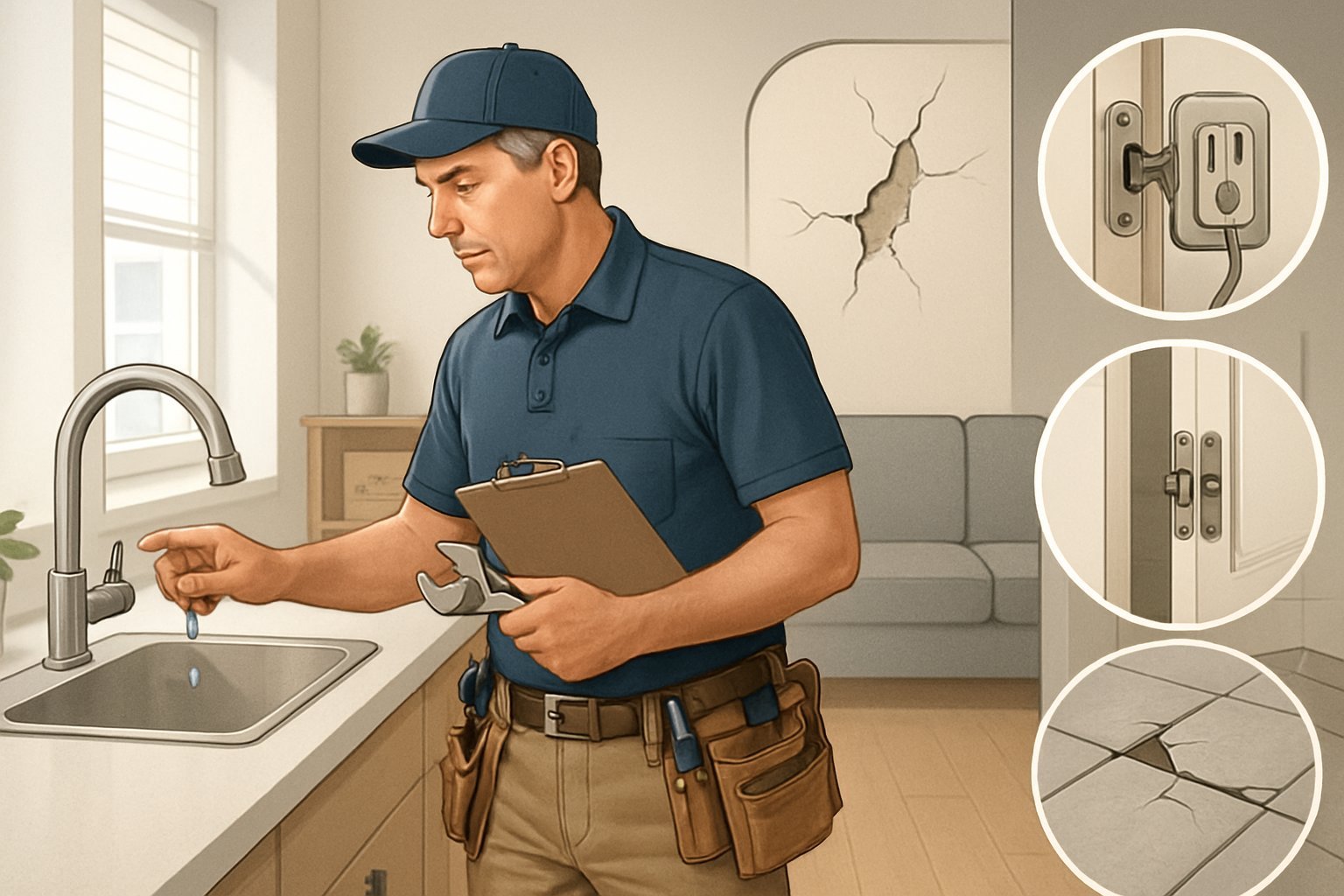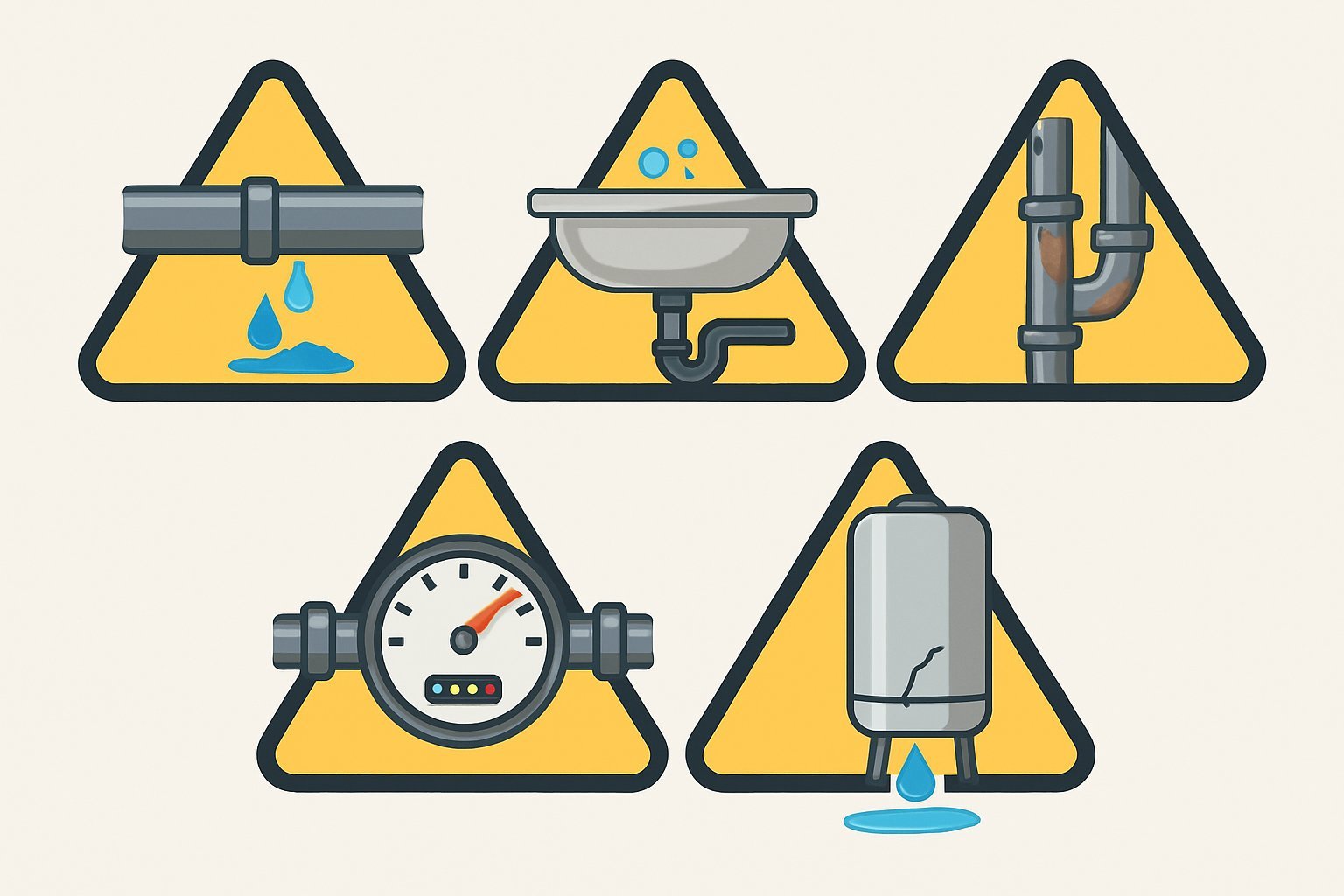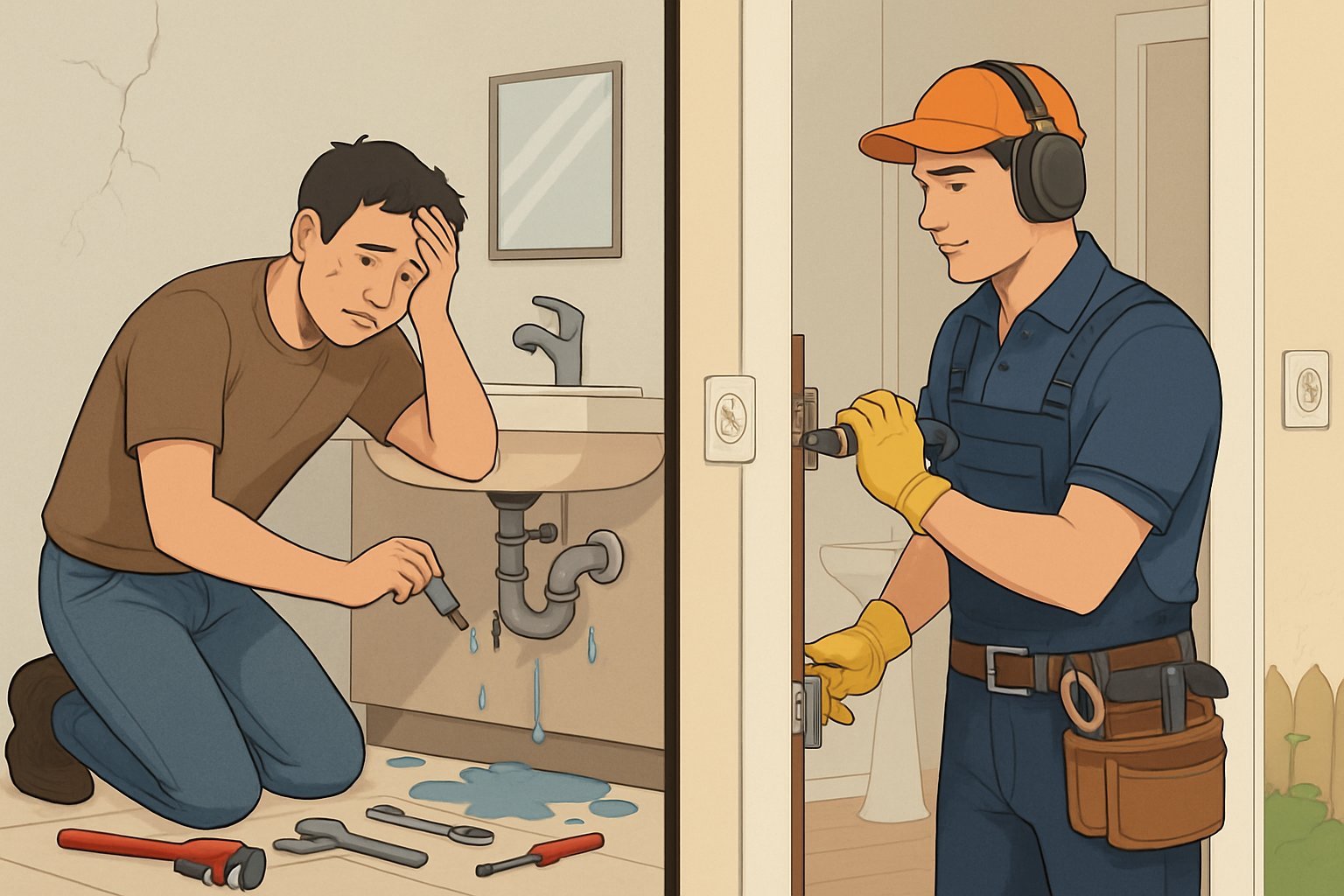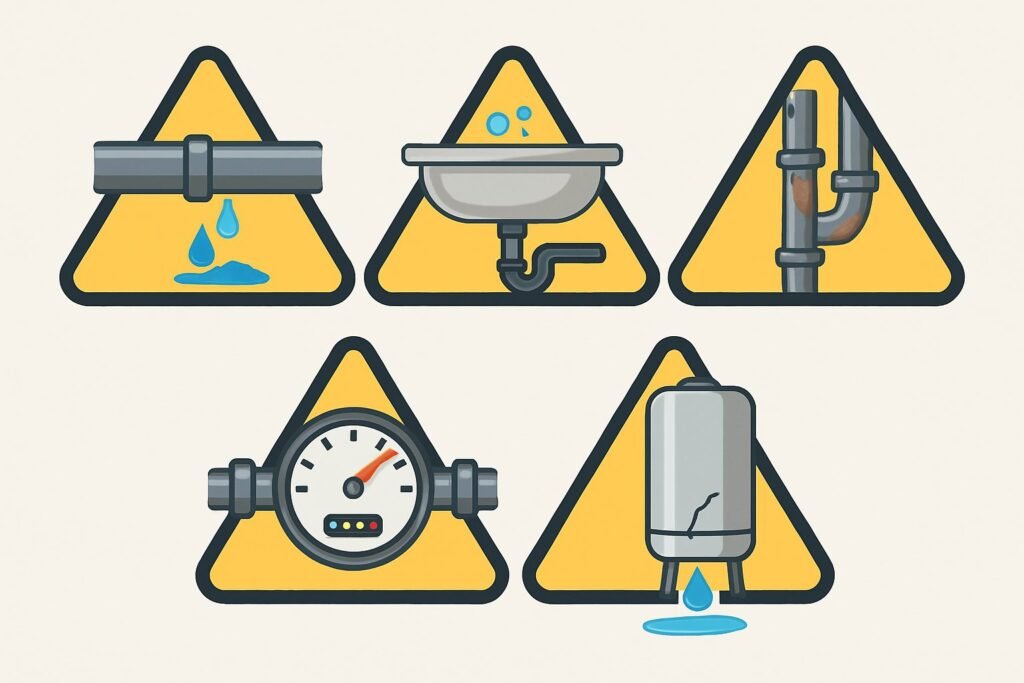Most homeowners keep a mental list of small repairs that never seem urgent. A squeaky door, a dripping faucet, or a crack in the wall—easy to brush off, right?

But small home maintenance issues can snowball into expensive repairs if you let them linger. What starts as a minor annoyance might turn into structural headaches, safety hazards, or a surprise emergency bill.
Spotting the early warning signs helps you decide when to try a fix yourself and when to bring in a pro. Catching problems early keeps fixes simple and affordable.
Key Takeaways
- Small home repairs can get expensive fast if you ignore them
- Warning signs like electrical problems and leaks mean it’s time to call a pro
- Acting early on repairs saves money and keeps your home safer
Recognizing the Top 5 Signs You Need a Handyman
Your house usually gives you hints before minor problems explode into big ones. Plumbing leaks, electrical weirdness, structural cracks, door issues, and moisture buildup—these are all red flags that scream for professional help.
Persistent Plumbing Issues
A dripping faucet can waste hundreds of gallons every month. That steady moisture isn’t just annoying—it can wreck cabinets and invite mold.
Common plumbing warning signs include:
- Faucets that won’t stop dripping
- Toilets that run constantly
- Low water pressure throughout the house
- Strange gurgling sounds from drains
Running toilets can waste up to 200 gallons a day. Usually, that’s a broken flapper or a fill valve gone bad.
If you have multiple clogged drains, there’s probably a bigger blockage in the main line. Sometimes tree roots or a busted pipe are to blame.
Spotting water stains under the sink? That’s a leak hiding out of sight. Let it go and you’ll end up with rotting wood or ruined flooring.
Handymen can knock out most plumbing fixes quickly. They know when it’s time to call in a licensed plumber if things get serious.
Electrical Problems or Unusual Outages
Flickering lights? That probably means loose wiring. It’s a fire risk and can fry your electronics if you let it go.
If your circuit breakers trip a lot, your system might be overloaded. Older homes often need electrical upgrades just to keep up with modern gadgets.
Dangerous electrical warning signs:
- Outlets that feel warm
- Burning smells from switches
- Sparks when plugging in devices
- Lights that dim when appliances kick on
Hear buzzing from an outlet? That’s arcing inside the wall—a legit emergency.
GFCI outlets that won’t reset lose their safety edge. Kitchens and bathrooms absolutely need working GFCIs to prevent shocks.
Handymen can swap out switches and outlets, but they’ll recommend a licensed electrician if the wiring gets complicated.
Structural Damage or Weakening
Little cracks in drywall? No big deal, usually just settling. But if those cracks are big or keep growing, you might have foundation trouble or water damage.
Squeaky floors could mean loose subflooring or damaged joists. Ignore it and you’ll risk a bigger headache—and maybe a safety hazard.
Structural warning signs to watch for:
- Doors that stick or won’t close
- Windows that are hard to open
- Cracks around door frames
- Sagging ceiling spots
Nail pops in drywall show wood moving behind the walls. If you see a bunch in one spot, get it checked out.
Big gaps between walls and baseboards usually mean settling. If those gaps are large, foundation issues might be brewing.
Handymen can handle minor structural fixes, but they’ll tell you if it’s time for a structural engineer.
Doors and Windows That Won’t Close Properly
Sticking doors or ones that won’t latch are more than annoying—they’re a security risk. Humidity and settling are usually to blame.
Warped frames keep doors from closing tight, letting in drafts and hiking up your energy bill.
Windows that won’t open are a safety problem, especially in emergencies. Painted-shut windows need careful work to avoid breaking glass.
Door and window problems include:
- Gaps around frames
- Handles that are tough to turn
- Drafts around the edges
- Locks that don’t work right
Sliding doors that jump off their tracks? Fix those right away. A heavy door off-track can cause real injuries.
Cracked or missing weather stripping lets energy leak out. Good sealing keeps utility bills down.
Handymen can adjust hinges, replace weather stripping, and rehang doors that have shifted.
Water Leaks or Moisture Buildup
Water stains on ceilings usually mean a roof leak or a busted pipe. Even tiny stains can hide big problems above.
Condensation on windows points to poor ventilation. Too much moisture breeds mold and rots wood.
Musty smells in the basement or crawl space? That’s a sign of moisture trouble. Standing water down there is a health and structural risk.
Moisture warning signs:
- Peeling paint on outside walls
- White, chalky stuff on basement walls
- Damp spots that never dry
- Water bills that keep climbing
Overflowing gutters dump water near your foundation, leading to basement floods and expensive repairs.
Cracked caulk around tubs and showers lets water sneak into walls, causing rot and mold.
Handymen can seal up small leaks and help with ventilation. Bigger moisture problems might mean calling a roofer or waterproofing pro.
Why DIY Repairs Sometimes Fail
Plenty of homeowners dive into DIY repairs hoping to save a buck, but sometimes they just make things worse. Lack of planning, wrong tools, or not enough experience are usually the culprits.
Common Mistakes Homeowners Make
Trying to fix plumbing with whatever’s in the junk drawer? That’s a recipe for disaster. You really need the right wrenches and pipe cutters.
Skipping safety steps is another big one. People forget to shut off water or power before starting—hello, injuries and floods.
Building codes exist for a reason, but most folks don’t know them. DIY electrical and plumbing fixes often fail inspection because of this.
Rushing the job leads to sloppy work. Everyone wants a quick fix, but skipping steps like double-checking measurements or letting things dry just backfires.
Buying cheap materials might seem smart at first, but they break down sooner. Quality parts last longer and save headaches later.
When DIY Repairs Can Make Problems Worse
Messing up electrical work is downright dangerous. Bad wiring can cause fires or shocks. Even swapping outlets can get risky if you don’t really know what you’re doing.
Plumbing mistakes often end in water damage. A small leak can become a full-blown flood if pipes aren’t sealed right. Water damage is way pricier to fix than just calling a plumber in the first place.
Structural fixes aren’t for amateurs. Removing a wall or beam without knowing if it’s load-bearing? That’s how homes become unsafe.
Roofing repairs? Not only do you risk falling, but a bad patch job lets water in and encourages mold.
And gas lines? Honestly, don’t even think about it. Gas leaks can cause explosions or poisoning. Leave that to licensed pros.
How to Distinguish Between Simple Fixes and Serious Issues
Simple fixes are things like changing light bulbs, tightening a loose screw, or unclogging a basic drain. They need basic tools and aren’t a big deal if you mess up.
Serious issues involve electricity, gas, plumbing behind walls, or anything structural. Those jobs need real training and sometimes a license.
Watch for these signs you need a pro:
- You’ve tried and failed a few times already
- You don’t recognize the tools or parts involved
- The work needs a permit
- There’s a safety risk—think electricity or gas
- The problem keeps getting worse
If you see water damage, sparks, or smell gas, call a professional right away. Some repairs just aren’t worth risking your safety or your home.
When Delaying Repairs Can Become Costly
Little problems can turn into wallet-busting disasters if you put off repairs too long. And it’s not just the repair bill—it hits your finances in sneaky ways, too.
Escalating Damage to Your Home
A small roof leak might cost $200 to fix right now. Wait a few months, and that same leak could run up a $4,000 tab for water-damaged ceilings, walls, and floors.
Water spreads fast. Once it gets inside your walls, it can rot the wood and grow mold in just a couple of days. Suddenly, a few missing shingles turn into a full-blown mold remediation project.
Plumbing leaks do the same thing. That drip under your sink? It can warp the cabinet and damage the wall before you know it. Mold loves these damp spots.
Foundation problems only get worse with time. Small cracks in basement walls let in water, which freezes, thaws, and makes the cracks bigger. Eventually, your home’s structure could be at risk—and the repair bill won’t be pretty.
Electrical issues can go from annoying to dangerous. A flickering switch might just be loose wiring now, but it could lead to a fire if you ignore it.
Hidden Costs of Neglect
Drafty windows and doors make your heating and cooling systems work overtime. That might add $30 to $50 to your utility bill every month.
Over the course of a year, that’s $360 to $600 just leaking away. The longer you wait, the more you pay.
Appliances take a beating when repairs get delayed. A clogged dryer vent makes it run longer, burns more electricity, and shortens its life—so you end up replacing it sooner.
Poor insulation and air leaks also push your furnace and AC to the breaking point. They wear out faster and cost more to repair.
Insurance companies might deny claims for damage caused by neglect. If you ignore a roof leak until it destroys your ceiling, don’t expect your insurer to cover it.
Emergency repair calls always cost more. Weekend or after-hours work can double or triple your bill, so staying on top of repairs just makes sense.
Impact on Property Value
Homes with visible maintenance issues usually sell for less. Buyers spot problems and start to worry there’s even more hidden damage.
Real estate agents say homes needing repairs tend to sit on the market longer. Buyers often avoid them or make lowball offers to cover the cost of fixing things.
Deferred maintenance can cut home value by 10% or more. So, on a $300,000 home, you might lose $30,000 just from putting off repairs.
Home inspections reveal delayed repairs. Inspectors find issues sellers hoped to hide. Buyers often negotiate lower prices or just walk away.
Some repairs get so expensive that owners decide to sell instead of fixing them. Foundation problems, which average about $4,500 to repair, often force quick sales at a discount.
Curb appeal takes a hit when exterior repairs get ignored. Peeling paint, busted gutters, and cracked walkways make a lousy first impression that’s tough to shake.
Plumbing and Water-Related Warning Signs

Water problems can wreck your house if you ignore them. A handyman can fix a lot of plumbing issues before they turn into wallet-busting disasters.
Low Water Pressure or Persistent Clogs
Low water pressure around the house usually means trouble in the main water line. If just one faucet is weak, you might have a clogged aerator or some mineral buildup.
A handyman can check for:
- Clogged aerators or showerheads
- Pipes blocked by mineral deposits
- Bad pressure regulators
- Shut-off valves not fully open
Persistent clogs that keep coming back are a sign you need help. When several drains clog at once, your main sewer line could be the culprit.
Watch out for:
- Slow drainage in multiple sinks or tubs
- Gurgling sounds in drains
- Water backing up in other fixtures
- Bad smells coming from drains
Don’t brush these off. A small clog can turn into a nasty sewage backup and major water damage before you know it.
Leaks and Flooding Risks
Water leaks often hide out behind walls for months. If you spot any signs of water damage, call a handyman right away.
Look for leak clues like:
- Unexplained high water bills
- Damp spots on walls or ceilings
- Peeling paint or wallpaper
- Musty smells or mold patches
- Water sounds when everything’s off
Flooding risks go up when leaks get ignored. Water can mess with your home’s structure and bring on mold and health problems.
A handyman can track down hidden leaks using special tools. They’ll fix loose pipe connections, swap out worn washers, and replace bad seals.
Don’t wait if you see water damage. Even a tiny leak can waste hundreds of gallons every month and slowly wreck your foundation.
Knowing When to Call a Professional vs. DIY

The line between DIY and calling a pro isn’t always clear. Safety, your skills, and how complicated the project is all play a part.
Safety Risks and Code Compliance
Electrical work can get dangerous fast. Handyman pros know how to handle wiring safely and follow the rules. DIY electrical jobs can cause fires, shocks, or expensive damage.
Most places require permits for big electrical work. A licensed handyman knows what’s needed and can pull the right permits.
Plumbing issues can flood your place in minutes. Swapping a faucet is one thing, but anything with water lines or sewage should go to a pro. One slip can cost you thousands.
Structural repairs matter for safety. Knocking down walls, fixing foundations, or patching roofs—leave those for the experts. You need real know-how and the right permits.
Anything with gas lines is just too risky for DIY. Only certified pros should touch gas appliances or repairs.
Assessing Your Skills and Tools
Be honest about your skills before you start a project. Simple fixes like changing bulbs or tightening screws are usually safe for most folks.
More complicated jobs need real experience. Installing fans, patching drywall, or fixing plumbing leaks aren’t great for beginners.
Tools matter too. Pro-grade tools aren’t cheap. Renting them for a one-off project can cost more than just hiring a handyman in the first place.
Time adds up, too. A pro might finish in two hours, while DIY could eat up your whole weekend.
If you’ve done similar projects before, you’ll have a better shot at getting it right. If not, maybe call in help.
The Value of Handyman Expertise
Handymen bring a lot of experience to the table. They spot issues homeowners miss and fix them before things get out of hand.
Quality work from a pro usually lasts way longer than a rushed DIY job. Redoing poor DIY work can get expensive, so sometimes it’s just smarter to hire out.
Handymen carry insurance and warranties. If something goes wrong during or after the repair, you’re covered.
They often get better prices on materials thanks to supplier connections. That can help balance out labor costs.
Pros work safely and know the local codes. They make sure everything’s up to standard, which helps you avoid costly mistakes and safety issues.
Finding a Reliable Handyman
Not every handyman delivers the same results. Spotting red flags and knowing what to ask can save you from headaches and wasted money.
Red Flags and Warning Signs
Watch out for handymen who show up uninvited or demand full payment upfront. That’s usually a bad sign.
Pricing Red Flags:
- Quotes that seem way too low
- Cash-only demands
- Requests for all the money before work starts
- Prices much higher or lower than others
Behavior Warning Signs:
- No written contract or estimate
- No local references
- Missing license or insurance
- Pushing you to sign right away
A good handyman gives you a written estimate and references. They’ll explain the work and answer your questions without rushing you.
If someone doesn’t call back or keeps showing up late, that’s another red flag. Communication matters.
How to Choose the Right Professional
Ask friends and neighbors for recommendations. Local referrals usually lead to the best results.
Check these qualifications:
- Valid business license
- Current insurance
- Solid BBB rating
- Recent positive online reviews
Get at least three written estimates to compare. A reliable handyman will check out the job in person before giving you a quote.
Ask these questions:
- How long have you worked in the area?
- Can you give me three recent references?
- What if something goes wrong after the job?
- Do you guarantee your work?
Actually call past customers. Ask about the quality, timeliness, and cleanup after the work.
Look for someone who specializes in your type of repair. If it’s plumbing, a handyman with plumbing experience beats a generalist every time.
Frequently Asked Questions
Homeowners wonder when to call in a pro versus doing it themselves. They also want to know about timing, costs, and what makes for a quality service provider.
How can I tell if a repair is beyond DIY and requires a professional handyman?
If anything electrical goes beyond swapping a bulb, call a pro. Flickering lights, tripped breakers, or sparking outlets can lead to fires or injuries.
Plumbing problems that aren’t just simple clogs need expert help. Water leaks inside walls, sewer issues, or gas lines can cause major headaches.
Cracks in load-bearing walls or foundation problems? Get a professional assessment. These affect your home’s safety.
Anything needing permits or code compliance should go to a licensed pro. They know the rules and keep things safe.
What are common home maintenance tasks that indicate a need for a handyman?
Dripping faucets waste water and damage cabinets or floors. Often, a quick washer swap can fix it.
Squeaky floors might mean loose boards or bigger structural issues. A handyman can figure out if it’s a quick fix or something more.
Cracks in drywall that keep growing could mean water damage or settling. Tiny cracks are normal, but big ones need a pro’s eye.
Running toilets waste water and drive up your bill. Sometimes it’s just a flapper, other times it’s more involved.
Doors or windows that stick could mean foundation settling or warped frames. If they get worse, call someone in.
Can waiting too long to hire a handyman lead to increased costs or damages?
Small leaks can destroy floors, walls, and framing over time. What starts as a drip can turn into mold and rot.
Ignoring electrical issues is risky. Faulty wiring or overloaded circuits are a fire hazard.
Foundation cracks only get worse. Early repairs are cheaper than major fixes down the road.
Pest entry points grow if left alone. Small gaps in siding or roofing let in more critters and cost more to fix later.
How frequently should I schedule a handyman for routine home inspections to prevent major issues?
Most homes do well with pro inspections twice a year. Spring and fall are good times to catch problems before the weather changes.
Newer homes (under five years old) might only need yearly checks. Older places usually need more attention as systems age.
Harsh climates call for more regular maintenance. Extreme weather beats up roofs, siding, and foundations.
After big storms, get an inspection right away. Damage can get worse fast if you don’t catch it early.
What qualifications should I look for when hiring a handyman to ensure quality work?
Licensed handymen have insurance and bonding. That protects you if something goes wrong.
References from recent customers tell you about reliability and work quality. Good handymen are happy to share them.
Experience matters, especially for complicated jobs. Electrical, plumbing, or other specialized work needs real training.
Written estimates and warranties are a must. Legitimate pros provide clear pricing and stand behind their work.
What types of home repairs are typically not covered under homeowner’s insurance, thus requiring a handyman?
Regular maintenance tasks like caulking or touching up paint are on you as the homeowner. Insurance just doesn’t step in for routine stuff like filter changes, either.
If termites or rodents chew through your place, that’s a separate headache. Most standard policies leave out damage from pests or critters, which is frustrating but true.
When your foundation settles or you spot a minor crack, don’t expect help unless a covered peril actually caused it. Gradual settling is just part of a house getting older, apparently.
Insurance also skips appliance repairs and replacements. If something breaks, you’re probably relying on a manufacturer warranty—if you even have one.

